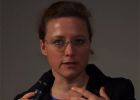Vilém Flusser, escritor-pensador. Modos de la escritura en El universo de las imagines técnicas
This article is part of a larger investigation about three “writer-thinkers”: Giorgio Agamben (Rome, 1942), Héctor Libertella (Bahía Blanca, 1945 – Buenos Aires, 2006), and Vilém Flusser (Praga, 1920 - 1991). As a “writer-thinker” Vilém Flusser proposes that these notions are reversible, in the same way that he stated that “active” and “passive” were no longer differentiable. His essays are based upon a strong reflection on language, which is made through the process of writing. In many ways, he uses writing to think, and thinking to write. This paper further explores his use of etymology, definitions, series, as well as the nature of writing and fiction, in order to write and think.
Art as Acting Against the Program of the Apparatus
Vilém Flusser is one of the first scholars to address the systems of technical media, as well as the biotechnological manipulation of the living world, in relation to the issue of programmability. In this regard Flusser questioned the position of the actor, the operator or perhaps the creator in these systems. If the functionary and the apparatus merge into a unit and apparatus has its program, what is the role the artist if he or she is not just anyone who is exhausting the options offered by the program? In the paper the functionary of the apparatus of the camera and the “creator” in the field of biotechnics are compared in order to establish the similarities in both “creative” practices of an (artistic) photographer and of a biotechnological artist, as well as discuss the similarities with other artistic practices discussed by Flusser. The apparatus functions as “intelligent machine” thus it has certain power. The subject involved in the game of the apparatus is subjected to its structure. The question is, how to establish the critical stance, how to act against the apparatus. This transposes the notion of an artist as a supposed creator to the notion of an artist as the one who resists the structures of power.

